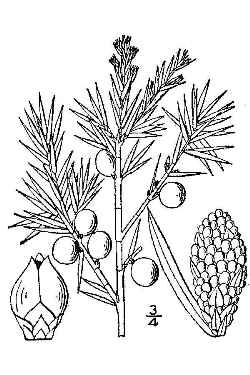
Britton, N.L., and A. Brown. 1913. Illustrated flora of the northern states and Canada. Vol. 1: 66. Courtesy of Kentucky Native Plant Society.
Sunset®: All zones
USDA: 2-9
Sun Exposure: Full sun to part shade
Origin: North America, Europe
Growth Habits: Evergreen shrub or tree, generally a mat-forming shrub reaching up to 5 feet in height (1.5 m) and 7 to 14 feet in spread (2-4 m), as a tree, it can reach 25 feet (7.5 m); green to gray-green, 0.3 to 0.5 inch long (7-12 mm), sword-like leaves
Watering Needs: Little water when established.
Propagation: Seeds, cuttings for the cultivars, either way is difficult
The Common Juniper is threatened or endangered in a number of states.
Propagation:
Common Junipers are dioecious, but can occasionally be monoecious. Male trees have small solitary yellow-brown, catkin like cones. Female trees have waxy, light blue-green, berry-like cones, 0.25 inch in diameter (6 mm). The immature female cones are red covered with a thin bloom, turning bluish-black and glaucous as they mature. Full maturity takes a couple of years.
Desert-Tropicals is dedicated to provide gardening advice, gardening ideas, and information about flower of all kind for landscape and collections.We try to check carefully the identification of the plants on the illustrations as well as the other information from the page, but occasionally errors do occur. if you notice anything that needs to be changed please contact us.Thanks.
© 1998-2020 Philippe Faucon, All Rights Reserved.